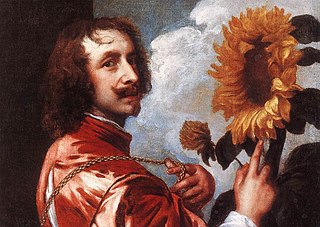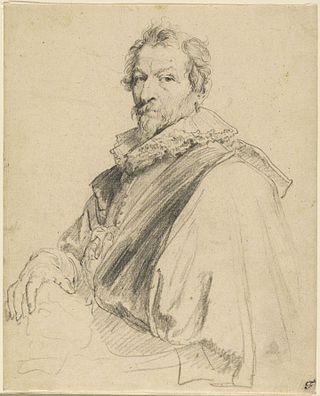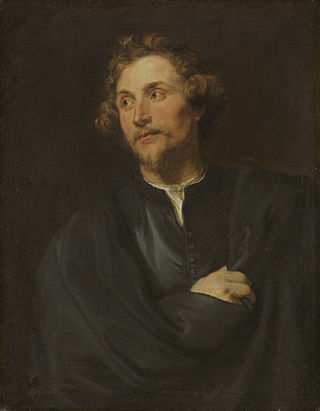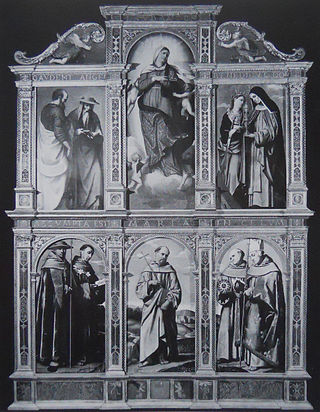
Sir Anthony van Dyck was a Flemish Baroque artist who became the leading court painter in England after success in the Spanish Netherlands and Italy.

The Wallace Collection is a museum in London occupying Hertford House in Manchester Square, the former townhouse of the Seymour family, Marquesses of Hertford. It is named after Sir Richard Wallace, who built the extensive collection, along with the Marquesses of Hertford, in the 18th and 19th centuries. The collection features fine and decorative arts from the 15th to the 19th centuries with important holdings of French 18th-century paintings, furniture, arms and armour, porcelain and Old Master paintings arranged into 25 galleries. It is open to the public and entry is free.

Simon Vouet was a French painter who studied and rose to prominence in Italy before being summoned by Louis XIII to serve as Premier peintre du Roi in France. He and his studio of artists created religious and mythological paintings, portraits, frescoes, tapestries, and massive decorative schemes for the king and for wealthy patrons, including Richelieu. During this time, "Vouet was indisputably the leading artist in Paris," and was immensely influential in introducing the Italian Baroque style of painting to France. He was also "without doubt one of the outstanding seventeenth-century draughtsmen, equal to Annibale Carracci and Lanfranco."

The Alte Pinakothek is an art museum located in the Kunstareal area in Munich, Germany. It is one of the oldest galleries in the world and houses a significant collection of Old Master paintings. The name Alte (Old) Pinakothek refers to the time period covered by the collection—from the fourteenth to the eighteenth century. The Neue Pinakothek, re-built in 1981, covers nineteenth-century art, and Pinakothek der Moderne, opened in 2002, exhibits modern art. All three galleries are part of the Bavarian State Painting Collections, an organization of the Free state of Bavaria.

Gaspar de Crayer or Jasper de Crayer was a Flemish painter known for his many Counter-Reformation altarpieces and portraits. He was a court painter to the governors of the Southern Netherlands and worked in the principal cities of Flanders where he helped spread the Rubens style.

Hendrick van Balen or Hendrick van Balen I was a Flemish Baroque painter and stained glass designer. Hendrick van Balen specialised in small cabinet pictures often painted on a copper support. His favourite themes were mythological and allegorical scenes and, to a lesser extent, religious subjects. The artist played an important role in the renewal of Flemish painting in the early 17th century and was one of the teachers of Anthony van Dyck.

Thomas Willeboirts Bosschaert was a Dutch Republic-born Flemish Baroque painter.

Georg Petel was a German sculptor and a virtuoso ivory carver. His work marks the beginning of Baroque sculpture in Germany.

Flemish Baroque painting was a style of painting in the Southern Netherlands during Spanish control in the 16th and 17th centuries. The period roughly begins when the Dutch Republic was split from the Habsburg Spain regions to the south with the Spanish recapturing of Antwerp in 1585 and goes until about 1700, when Spanish Habsburg authority ended with the death of King Charles II. Antwerp, home to the prominent artists Peter Paul Rubens, Anthony van Dyck, and Jacob Jordaens, was the artistic nexus, while other notable cities include Brussels and Ghent.

Lucas Franchoys the Younger or Lucas Franchoys II was a Flemish Baroque painter from Mechelen, who painted numerous altarpieces and portraits in a style reminiscent of Anthony van Dyck.

Sir Peter Paul Rubens was a Flemish artist and diplomat from the Duchy of Brabant in the Southern Netherlands. He is considered the most influential artist of the Flemish Baroque tradition. Rubens's highly charged compositions reference erudite aspects of classical and Christian history. His unique and immensely popular Baroque style emphasized movement, colour, and sensuality, which followed the immediate, dramatic artistic style promoted in the Counter-Reformation. Rubens was a painter producing altarpieces, portraits, landscapes, and history paintings of mythological and allegorical subjects. He was also a prolific designer of cartoons for the Flemish tapestry workshops and of frontispieces for the publishers in Antwerp.

The 1821 Derby at Epsom, or Horse Race is an 1821 painting by Théodore Géricault in the Louvre Museum, showing The Derby of that year.

Justus van Egmont or Joost van Egmont was a painter and a tapestry designer during the 17th century. After training in Antwerp with Gaspar van den Hoecke and working with Anthony van Dyck, van Egmont also worked in Peter Paul Rubens' workshop. He moved to France in 1628 where he was a court painter for the House of Orléans. In France he helped to found the Académie de peinture et de sculpture. He later returned to Flanders where he worked in Antwerp and Brussels. He is mainly known for his portrait paintings, although he also painted some history subjects, and produced designs for five different tapestry series.

Charles I at the Hunt – also known under its French title, Le Roi à la chasse – is an oil-on-canvas portrait of Charles I of England by Anthony van Dyck c. 1635, now in the Louvre Museum, Paris. It depicts Charles in civilian clothing and standing next to a horse as if resting on a hunt, in a manner described by the Louvre as a "subtle compromise between gentlemanly nonchalance and regal assurance".

Jacob van Oost or Jacob van Oost the Elder (1603–1671) was a Flemish painter of history paintings and portraits. He was the most important painter of Bruges in the 17th century through his portraits of members of the local bourgeois and his many altarpieces made in the spirit of the Counter-Reformation. He also created genre paintings of musicians and card players for the open market.

The Crucifixion is an oil on canvas painting by Anthony van Dyck, produced c. 1630. It is 2.51 m high.

Cupid and Psyche is an oil on canvas painting by Anthony van Dyck. It is now in the Royal Collection and shown in Kensington Palace.

St Martin Dividing his Cloak is a painting by the Flemish painter Anthony van Dyck dated around 1618, which is an altarpiece in the Sint-Martinuskerk in Zaventem, Belgium. The painting portrays the story of Saint Martin sharing his cloak with a beggar. This early work of van Dyck was painted when he was strongly influenced by Rubens's style.

Everhard or Eberhard Jabach was a French businessman, art collector and director of the French East India Company. He was born in Cologne in the Holy Roman Empire but later naturalised as a French subject.

The Assumption Altarpiece was a 1529-1530 multi-panel painting by Moretto da Brescia. It is mainly oil on panel, although the two angels on the cornice are in tempera grassa verniciata.




















